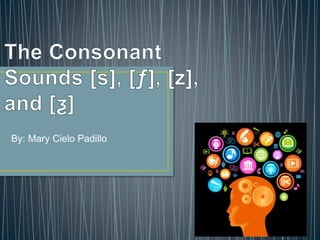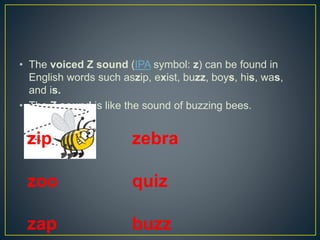The consonant sounds [s], [╞Т
- 1. By: Mary Cielo Padillo
- 2. Objectives: тАв Cognitive: Familiarize the sounds and symbols of [s], [╞Т], [z], and [╞║]through teacher- guided exercises; тАв Affective: Appreciate the importance of having good communication. тАв Psychomotor: Produce accurately the sounds [s], [╞Т], [z], and [╞║]in words, phrases and sentences тАв Perform classroom tasks using the sounds [s], [╞Т], [z], and [╞║] through reinforcement activities.
- 4. тАв The voiceless (unvoiced) S sound (IPA symbol: s) can be found in English words such as said, sad, sit, box, bus, cats, face, and circle. тАв The S sound is a hissing sound like a snake. say sad So sits sound
- 5. тАв The voiced Z sound (IPA symbol: z) can be found in English words such aszip, exist, buzz, boys, his, was, and is. тАв The Z sound is like the sound of buzzing bees. zip zoo zap zebra quiz buzz
- 6. Let's look at a few rules for some of the common spellings. тАв s spelling (sit, wise, dogs, cats) The s spelling is sometimes pronounced as an S sound (sit, cats) and sometimes as a Z sound (wise, dogs) It is more likely to be pronounced as a Z sound if it comes between two vowel sounds: wise, visit, busy. There are not many rules to help us know which sound is used, so it is very important to learn the correct pronunciation of each new word.
- 7. тАв sc spelling (science, descend, score) The sc spelling can be pronounced as an S sound alone or as an S + K sound. It is more likely to be pronounced as an S sound when it comes in the middle of a word, but not all words follow the rule. S sound = muscle, descend, science S + K sound = scream, score, scare
- 8. тАв x spelling (fox, exist) The x spelling can be pronounced in two different ways: K + S sound = fix, fox, next G + Z sound = example, exist *Note: "Exit" can be pronounced as an K + S sound or G + Z sound. Either way is accepted.
- 9. тАв Both of these sounds are produced in the front part of your mouth. When you make these sounds, your lips will be slightly open. Your teeth should lightly touch in the front or be very close together. The front of your tongue will touch the back of your lower teeth. The back of your tongue touches the roof of your mouth on the sides. When making the S and Z sounds, air is pushed down the center of your tongue and between the tip of your tongue and your top teeth. The movement of the air makes the S and Z sounds.
- 10. тАв The voiceless (unvoiced) SH sound (IPA symbol: ╩Г ) can be found in English words such as shop, brush, sure, chef, station, special, precious, and pressure. shop she shirt ship shot shy
- 11. тАв There are a few words with the ch spelling that are pronounced with theSH sound. (Most of the time, the ch spelling is pronounced as the CH sound: chip, chat, rich.) тАв chef тАв machine тАв moustache
- 12. тАв The SH sound is also sometimes found in these suffixes: -tion / -sion -cial / -tial -itious solution тАв addition тАв direction
- 13. тАв The voiced ZH sound (IPA symbol: ╩Т) can be found in English words suc тАв The ZH sound is not a very common sound in English. The words that are pronounced with the ZH sound are advanced vocabulary words. Many students find it easier to memorize words that have this sound rather than learn complicated spelling rules. as garage, decision, measure, visual, and Asia.
- 14. тАв To make the SH and ZH sounds, you pull in the sides of your mouth so your lips pucker. Your lips are shaped like a loose, open kiss.
- 15. [s] [╞Т] [z] [╞║] Sweden Schist Zygote Deja vu Society Seychelles Xylophone collage Singapore Induction Zonal mirage Saudi Arabia Ammunition Ablaze beige Slovakia Sheik Tyrannize azure Strangle Attention Tanzania page
- 16. тАв ESSENTIAL QUESTION: тАв How important is good communication skills in our lives?


![Objectives:
тАв Cognitive: Familiarize the sounds and symbols of [s], [╞Т], [z],
and [╞║]through teacher- guided exercises;
тАв Affective: Appreciate the importance of having good
communication.
тАв Psychomotor: Produce accurately the sounds [s], [╞Т], [z],
and [╞║]in words, phrases and sentences
тАв Perform classroom tasks using the sounds [s], [╞Т], [z], and
[╞║] through reinforcement activities.](https://image.slidesharecdn.com/theconsonantsoundss-160717120445/85/The-consonant-sounds-s-2-320.jpg)
![The consonant sounds [s], [╞Т](https://image.slidesharecdn.com/theconsonantsoundss-160717120445/85/The-consonant-sounds-s-3-320.jpg)











![[s] [╞Т] [z] [╞║]
Sweden Schist Zygote Deja vu
Society Seychelles Xylophone collage
Singapore Induction Zonal mirage
Saudi Arabia Ammunition Ablaze beige
Slovakia Sheik Tyrannize azure
Strangle Attention Tanzania page](https://image.slidesharecdn.com/theconsonantsoundss-160717120445/85/The-consonant-sounds-s-15-320.jpg)
